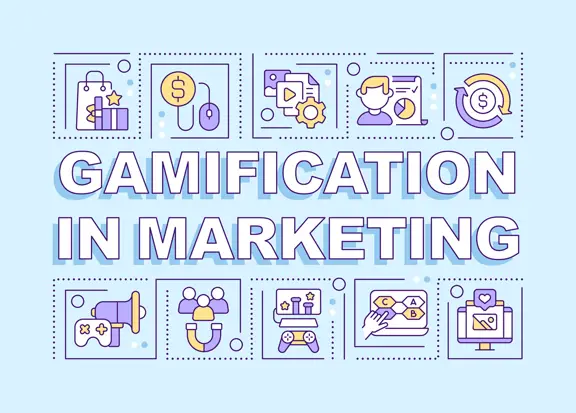Unleashing the Power of Gamification in your Business
In light of the continuously changing consumer economy and ever-evolving technology, gamification is increasingly acknowledged as a crucial strategy for increasing motivation and engagement for all people. Aniday will help you obtain a greater grasp of the notion of gamification in this post, as well as study its history, development trends, and why it has become so popular.
What is Gamification?

Gamification, a term derived from "game" and "modification," involves using game elements like scoring, leaderboards, badges, and achievements to incentivize and engage users in various activities.
Consider an example of a language-learning mobile app using a scoring system and leaderboards to make learning more exciting and less mundane. This is a specific example of gamification.
In addition, gamification is widely applied in real-life scenarios such as:
-
Customer loyalty programs that use rewards and badges to encourage customers to shop more.
-
Fitness apps that use scoring and leaderboards to motivate users to exercise regularly.
-
Recognition programs that use achievement leaderboards to encourage employees to work more efficiently and achieve organizational goals.
Gamification's recent popularity is driven by technology, like mobile devices and AI, and a better understanding of human psychology's role in using game elements for motivation and engagement. Acknowledging this tendency, businesses and institutions have started utilizing gamification to more easily accomplish their objectives.
Gamification has grown in popularity because it provides numerous benefits to consumers, including:
-
Motivation: Gamification helps users maintain interest and motivation in activities.
-
Encouraging learning: Gamification assists users in learning and acquiring knowledge more effectively.
-
Enhancing interaction: Gamification encourages interaction between users and the system.
Elements of Gamification
Goals and rewards are among the most important elements of gamification. Goals provide users with direction and motivation to participate in activities, while rewards are a way to commend users for their achievements.
Rules and Guidance
Rules and guidance help users understand how to play the game. They aid users in knowing what they need to do to achieve their goals and receive rewards.
Game Design and Game Elements
Game design and game elements create an engaging and exciting gaming experience. They include elements such as graphics, sound, storytelling, etc.
Interaction and Challenges
Interaction and challenges help users engage with the game. Interaction encourages users to interact with each other and the system. Challenges make users feel excited and motivated to push their limits.
Success Measurement Standards
Success measurement standards assess the effectiveness of gamification. They include metrics such as the number of users participating, the number of goals achieved, and more.
Applications of Gamification
Gamification can be applied in various fields, including:
-
Education: gamification is used to help learners study and acquire knowledge more efficiently.
-
Recruitment: gamification helps recruiters identify potential candidates by creating interactive games or tests. Challenges like problem-solving, teamwork, or even coding in a simulated environment can help recruiters evaluate candidates' actual skills.
-
Marketing and Business: gamification has become a crucial component of strategies aimed at fostering engagement, attracting customers, increasing sales, and establishing brand recognition.
-
Technology Products and Applications: gamification is used to make the user experience better and fascinating.
Benefits and Challenges of Gamification

Gamification brings significant benefits to businesses and organizations, including:
-
Motivating and Encouraging User Engagement: Gamification uses game elements to create an enjoyable and enticing experience, making users feel enthusiastic and eager to participate in activities.
-
Helping Users Learn and Absorb Knowledge More Efficiently: Gamification utilizes game elements to break down tasks into smaller, more manageable parts. This can help users learn and absorb knowledge more efficiently.
-
Enhancing Interaction Among Users and with the System: Gamification employs game elements to encourage user interaction with each other and the system, which can help build a community and improve the user experience.
-
Improving the User Experience: Gamification can generate a more exciting, engaging, and interactive user experience, attracting and retaining users.
-
Increasing Efficiency and Performance: Gamification can help users achieve their goals more effectively, potentially leading to increased productivity and effectiveness.
However, gamification can also encounter various challenges and potential risks. When not designed and implemented correctly, it can backfire, causing users to feel pressured, stressed, and even lead to misuse.
Specific Examples
Nike+ is a fitness tracking app that uses gamification to motivate users to exercise, while Duolingo is a language learning app that employs gamification to help users learn languages more effectively.
In addition to successful gamification implementations, there are cases of gamification done wrong, such as My Coke Rewards, a Coca-Cola loyalty program that failed due to its complexity and My Starbucks Rewards, a Starbucks loyalty program lacking compelling rewards to motivate users.
These failures demonstrate that gamification is a powerful tool but should be used carefully to avoid missteps. Businesses and organizations should thoroughly research before implementing gamification to ensure a deep understanding of gaming elements and how to use them effectively.
How to use Gamification Effectively
To use gamification effectively, it is essential to:
-
Define your goals. What do you want to achieve with gamification?
-
Understand your audience. Who are they, and what interests them?
-
Design a suitable gamification system that aligns with your goals and audience.
-
Test and adjust your system. Listen to user feedback and make adjustments to ensure a good fit.
Conclusion
Gamification is not just a game; it is a powerful tool for changing behavior, creating motivation, and providing a positive experience. From education to business and technology, gamification can be applied in various fields to create value. At a time when interaction and engagement play a crucial role in customer decision-making, gamification has proven its importance.
Try implementing gamification in your business, and you will witness its incredible effects. We hope this post from Aniday is helpful for you.
Aniday's HR Services
Headhunting Service
Find and recruit quality candidates in just 1 week! Supported by 40,000 experienced headhunters in IT, Finance, Marketing… capable of recruiting in any region.
Headhunting Service ➔Employer of Record (EOR) Service
On behalf of your business, we recruit employees and handle payroll without the need to establish a company in markets such as Vietnam, Singapore, Malaysia, India, Indonesia…
Employer of Record (EOR) Service ➔
